Discover the rich and diverse heritage of Alice Springs and the Central Australian region, encompassing natural and cultural wonders from both indigenous and non-indigenous perspectives. Explore these captivating destinations that promise to make your experience in "The Alice" and Central Australia truly unforgettable.
Central Australia was, for thousands of years before the coming of Europeans, occupied by various sub-groups of the Arrernte (Aranda) peoples, stretching past Hermannsburg to the west, beyond Arltunga to the east, as far as Aileron to the north and almost to Oodnadatta in the south. Significant aboriginal sites able to be visited today include Corroboree Rock, Standley Chasm (Angerkle Atwatye) and the Ewaninga (Napwerte) Rock Carvings.
Between 1860 and mid-1862, John McDouall Stuart made three failed attempts to become the first European explorer to traverse the country from Adelaide to the coastline of the Arafura Sea (near present-day Darwin) before finally succeeding in late 1862. Although he never actually came up through The Gap in the McDonnell Ranges, the town of Alice Springs originally bore his name and today has many places named in his honour, including Stuart Park and the Stuart Highway.
Stuart’s explorations enabled the construction of the Overland Telegraph Line between 1871 and 1872, together with the regularly-spaced Repeater Stations, such as the Alice Springs and Barrow Creek Telegraph Stations, that linked Australia telegraphically, across Asia and Europe, to Britain. That same year, the first of the pastoral stations, such as Owen Springs and Undoolya, were being carved out and in 1877, the Lutheran Mission at Hermannsburg was established.
In 1888, the small settlement of Stuart Town (re-named “Alice Springs” in 1931) was proclaimed and its first 104 lots (essentially the present-day Central Business District) were surveyed.
The discovery of gold at Arltunga, in 1887, saw an influx of prospectors make their way on foot in search of their fortune and, for quite a while, they represented the largest non-indigenous population in the region. Stuart Town, by contrast, only had a “white” population of a dozen people, out-numbered even by the Telegraph Station to its north.
The town and the region continued to grow and the early part of the new century saw many developments, including the construction of a new Town Gaol in 1908 and the establishment of a hotel, a saddlery and two general stores.
In 1926, the town’s first hospital, Adelaide House, was built, followed soon after by the Old Courthouse and The Residency (1928) and the town’s first school, the Old Hartley Street School (1929). These developments heralded the arrival of the railway link from the southern states in 1929, as evidenced by the Railway Cottages on Railway Terrace.
Air services followed with the creation of the Town Aerodrome in the late-1930s and the launching of Connellan Airways in 1939.
The town’s new General Cemetery, established in 1931 to the south of the Town Aerodrome, began to take over from the earlier Stuart Town Cemetery, located in George Terrace. In 1934, the RSL Monument was erected on Anzac Hill, commemorating the fallen of WWI.
Growth of the town accelerated towards the beginning of World War II, reflected in the electrification of the town in 1937; the establishment of the Royal Flying Doctor Service (1939); the building of the Wallis Fogarty Store (1939); Tuncks’ Store; the government officers’ houses in the Heritage Precinct (1938 - 43); and the construction of the town’s New Prison, presently occupied by the National Pioneer Women’s Hall of Fame.
The war years (1939 - 45) accelerated development of the town, with improvements in water supplies and the sealing of the North Stuart Highway resulting from the need to defend Australia against the Japanese advance and the re-location to Alice Springs of the Territory’s administration following the bombing of Darwin in 1942. Little physical evidence has survived of the once-extensive military presence, but for the odd Sidney Williams Hut (such as the present day Totem Theatre); the Officers’ Mess at 4 Hele Crescent; and the Munitions Bunker on Gosse Street. The
RSL Museum is a great source of information on this period of the town’s history.
The war years saw very few non-military building, with the exception of the Pioneer Walk-in Theatre, presently occupied by the YHA.
Following the end of WWII in 1945, the town experience an even greater rate of growth, as many soldiers who had passed through the town returned to settle in “A Town Like Alice”. The growth was assisted by the Army’s sale of surplus war buildings, materials and equipment, enabling improvements in the township and pastoral stations, the opening up of the Farms Area south of the Gap, and the establishment of a fledgeling tourism industry. Regular tours began to run to Ayers Rock and The Olgas, Simpson Gap and Palm Valley, and the town’s first man-made attraction was established: the Pitchi Richi Sanctuary, just south of The Gap.
In 1952, John Flynn’s Grave was erected in recognition of his contribution towards the development of Alice Springs and outback Australia. Four years later, the John Flynn Memorial Church (1956) was also built in his honour.
The 1960s and 70s saw tourism continue to grow, as the town came to epitomise The Outback through books and movies of the time, such as “A Town Like Alice”, “Jedda” and “The Overlanders”. New Hotels, such as The Riverside (Todd Tavern) and many of the surviving commercial buildings, such as the Heenan Building at the southern end of Todd Mall, were built at this time.
Interest in the history of the town and the central Australian region has continued to the present day, with the establishment of the National Pioneer Women’s Hall of Fame, the Central Australian Aviation Museum, the Strehlow Centre, the Araluen Art Gallery, the National Road Transport Hall of Fame, the Old Ghan Railway Museum and the Alice Springs Desert Park.
All in all, The Alice has something for anyone who appreciates the importance of looking after heritage for future generations.
Heritage
Locations
In Alice Springs
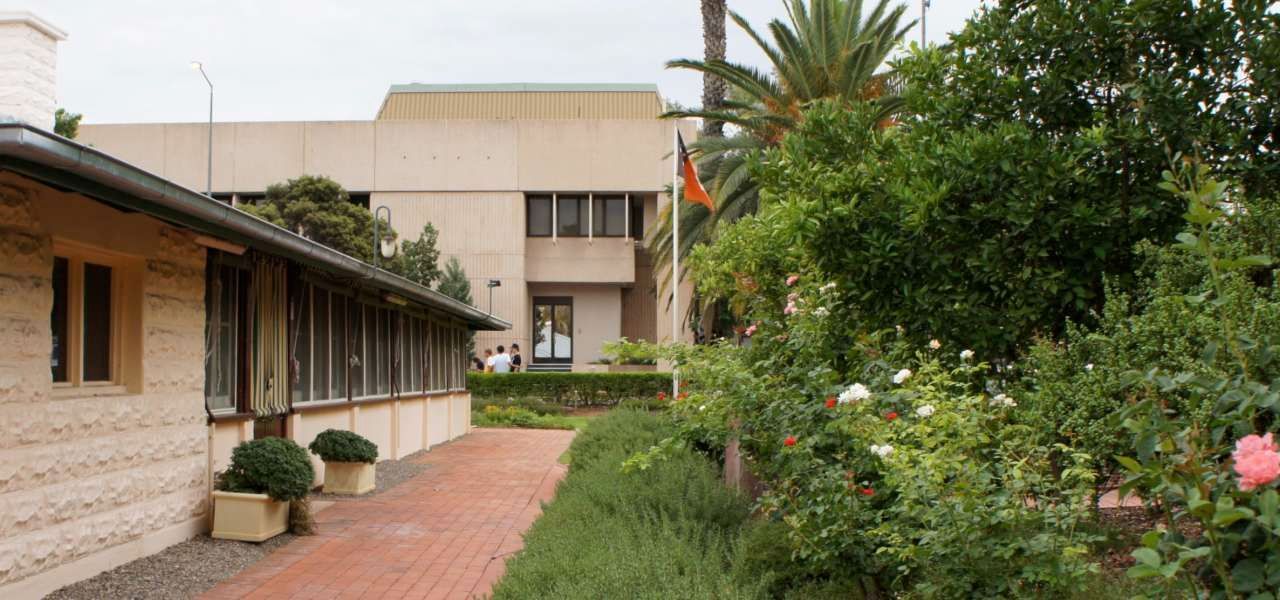
The Residency
The Residency is one of the towns more unique heritage places, its significance as the short-lived “capital” of Central Australia makes it of importance on a national level.
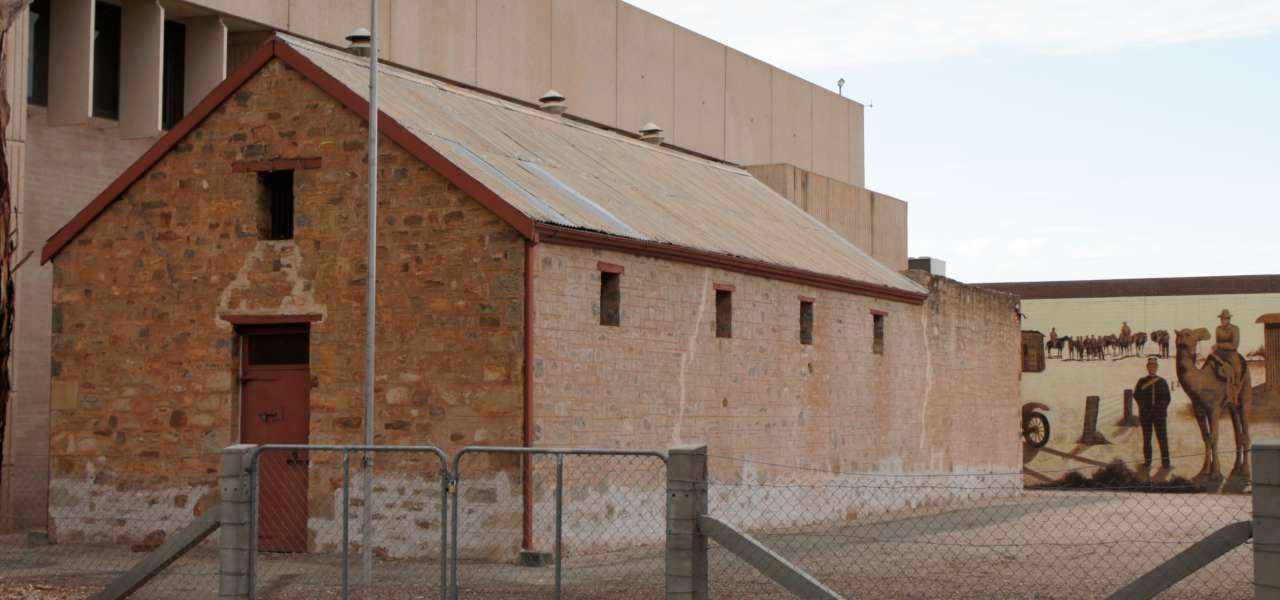
Old Stuart Town Gaol
Built in 1908 of local stone, the Old Stuart Town Gaol is the oldest surviving building in Central Business District of Alice Springs, serving until 1939 and the establishment of the new prison.
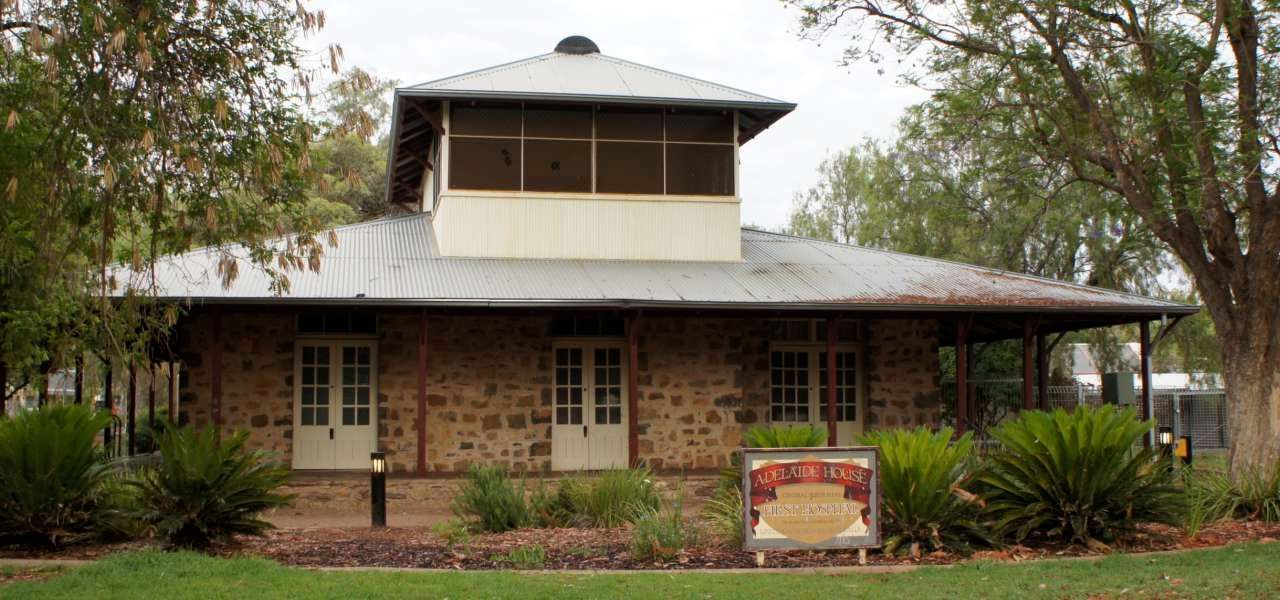
Adelaide House
Completed in 1927 to a design by the Rev. John Flynn, Adelaide House served as the region’s only hospital until 1939, employing a unique cooling system based upon the “Coolgardie safe”
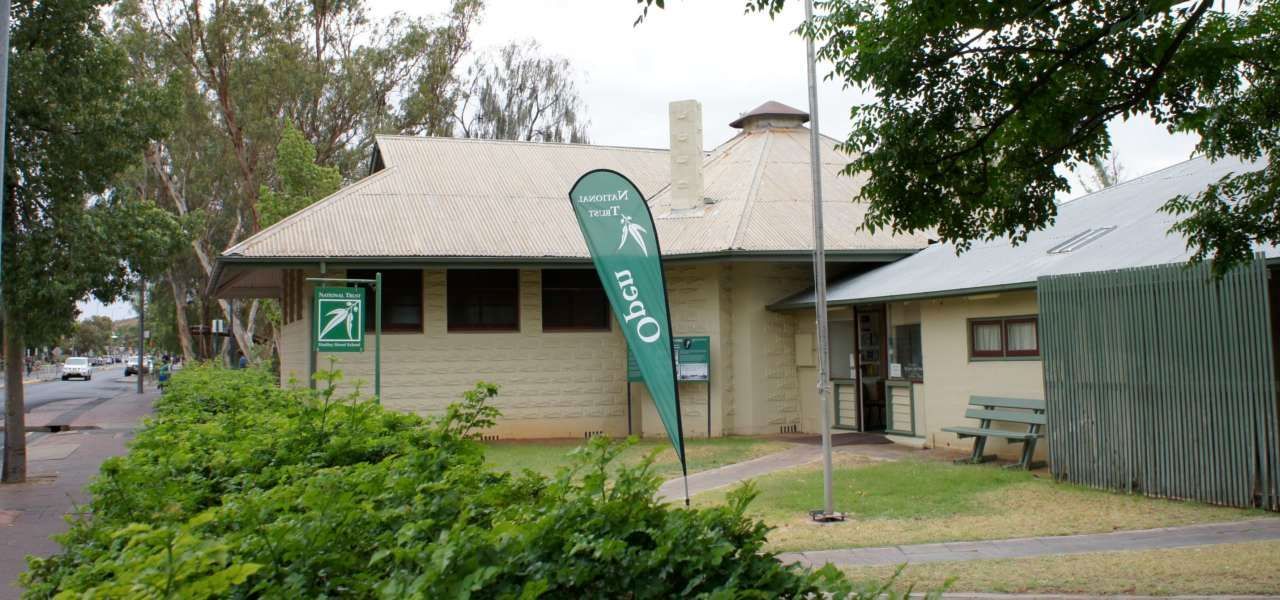
Old Hartley Street School
Established in 1930 as the town’s first purpose-built school, the Old Hartley Street School served until 1965, with its unique 1945 octagonal Kindergarden extension.
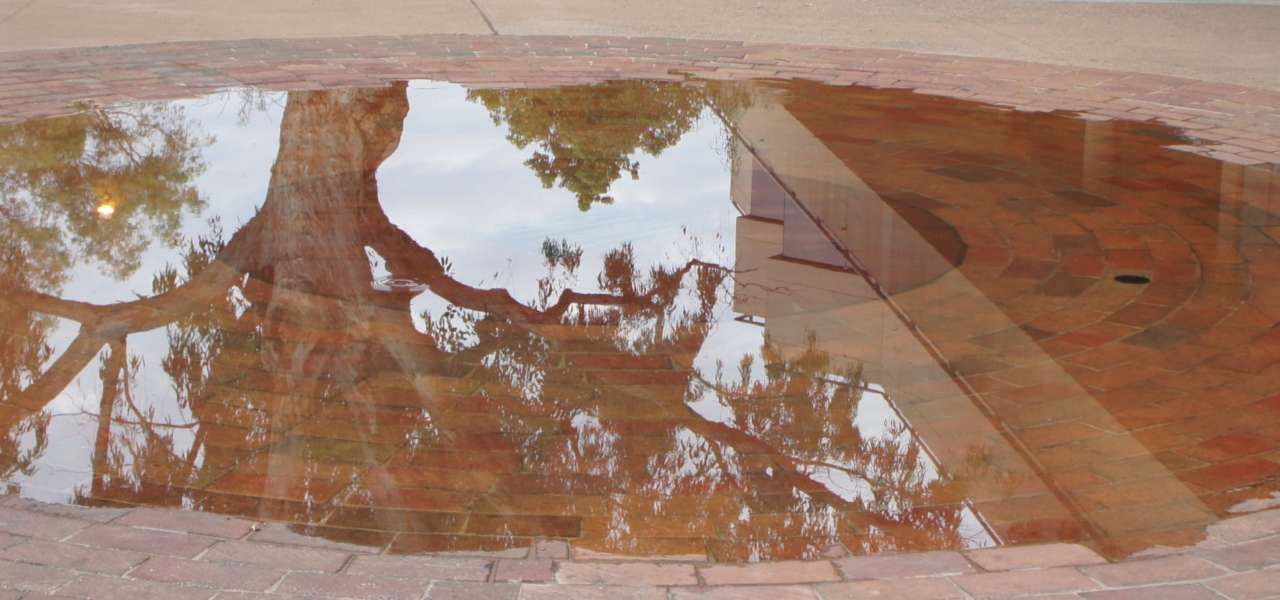
River Red Gum
This River Red Gum, the last to survive in this part of the Town Centre, is evidence of past river flood levels. It is sacred to the Arrernte people and is protected under the Aboriginal Areas Protection Authority.
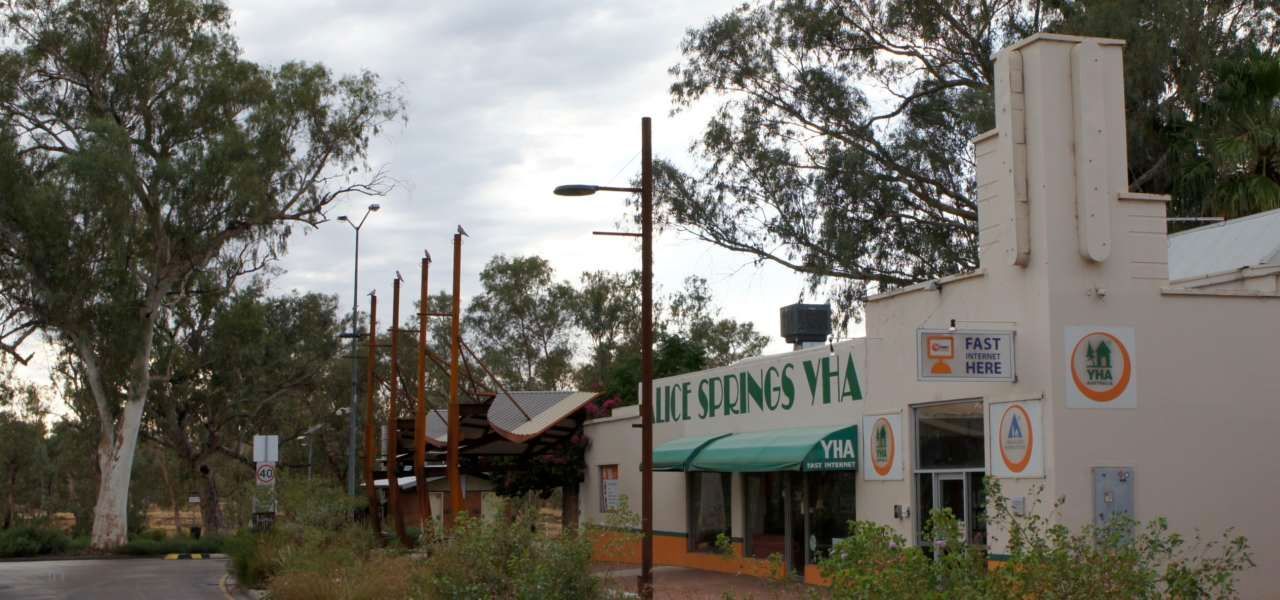
Former Pioneer Walk-in Theatre
One of only a few surviving buildings from the WWII era, the open-air theatre entertained the troops and was the scene for the world premiere screening of “A Town Like Alice”. Today, it is occupied by the YHA.
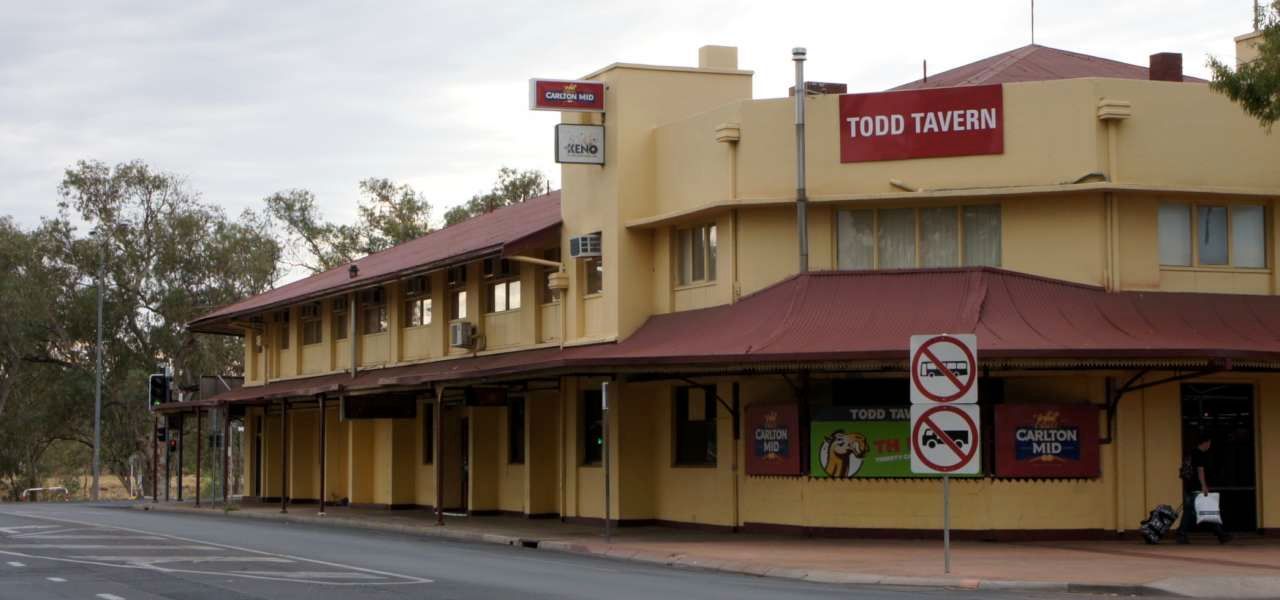
Former Riverside Hotel
Built in 1960 to a design by noted Territorian architect, Beni Burnett, the historic Riverside Hotel (re-named The Todd Tavern) is the last remaining traditional-styled pub in town.
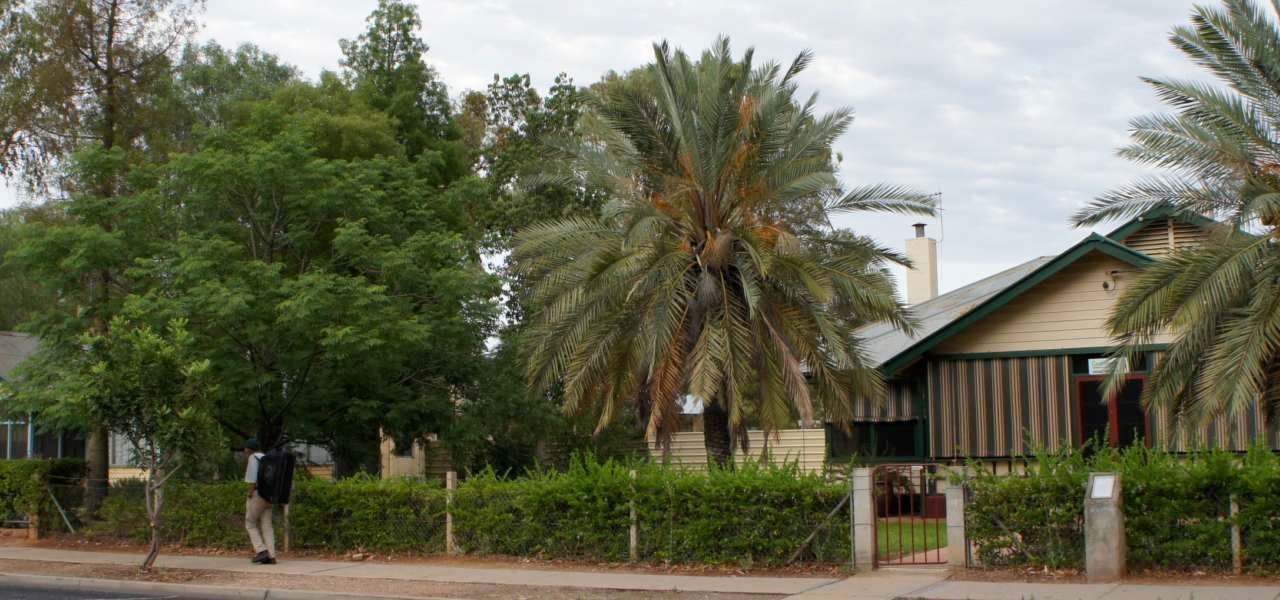
Alice Springs Heritage Precinct
Established in 1939 as a new subdivision for government infrastructure, the precinct features several Official’s Houses, many designed by Beni Burnett, as well as Stuart Park, the new Hospital and Prison.
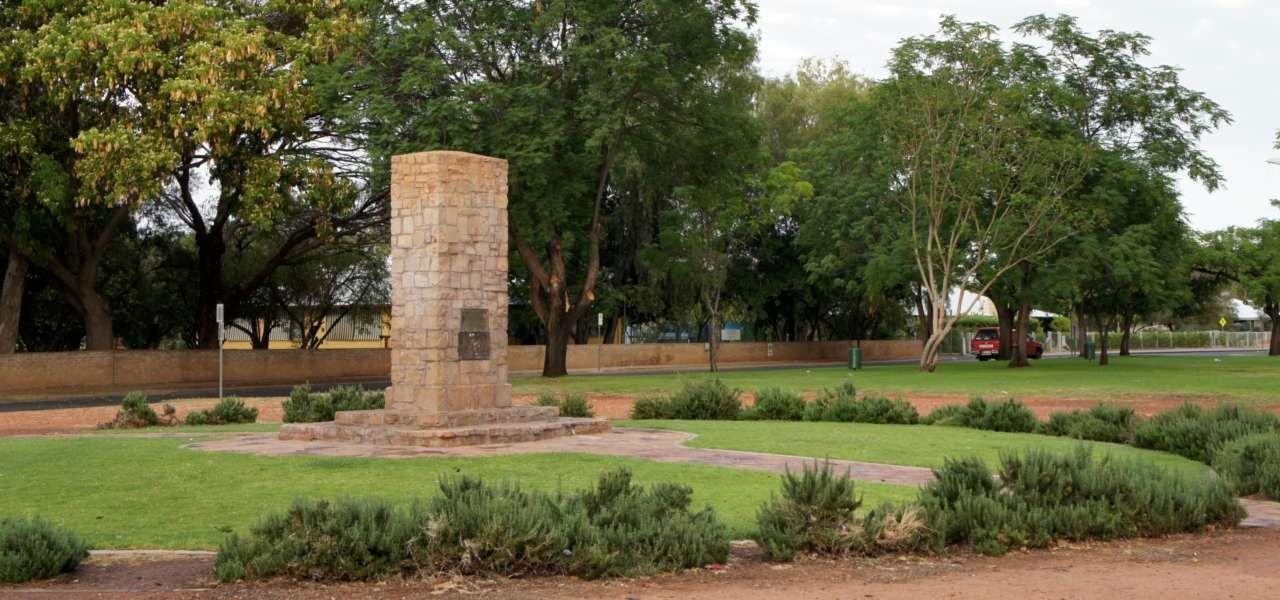
Stuart Memorial, Stuart Park
Erected in 1939, the Stuart Memorial commemorates John McDouall Stuart’s four expeditions attempting to traverse Australia from south to north, a feat he finally achieved in 1862.
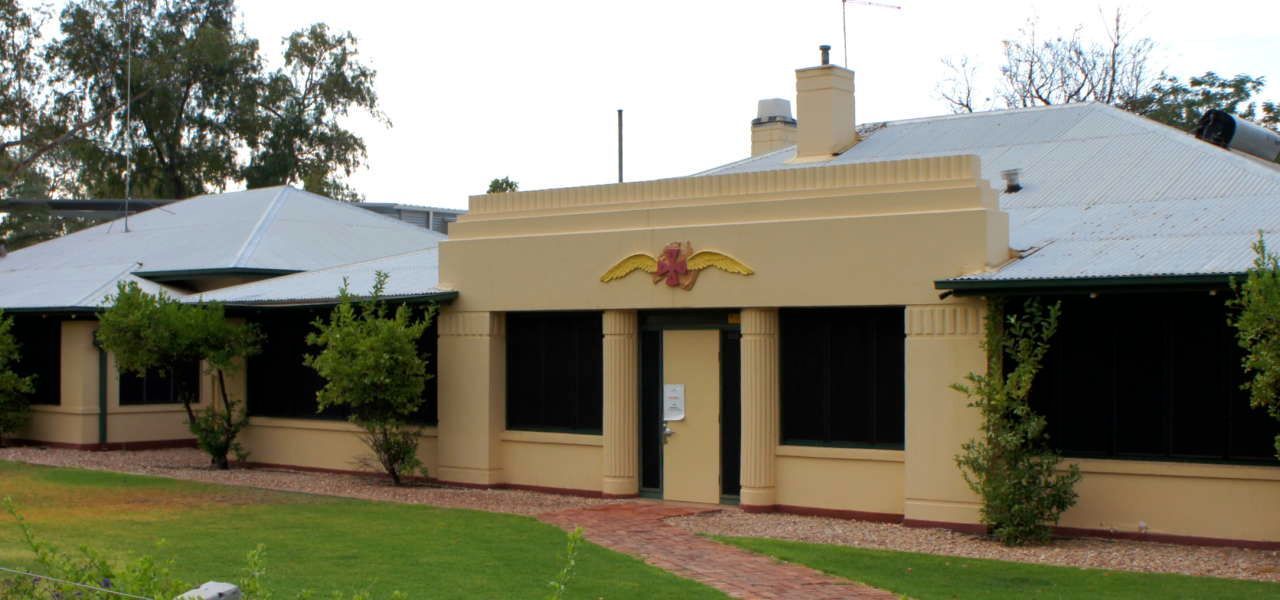
Royal Flying Doctors Service
The Alice Springs Royal Flying Doctor Service base, established in 1939, helped expand essential medical services into Outback Australia, with innovative use of Aviation and Radio.
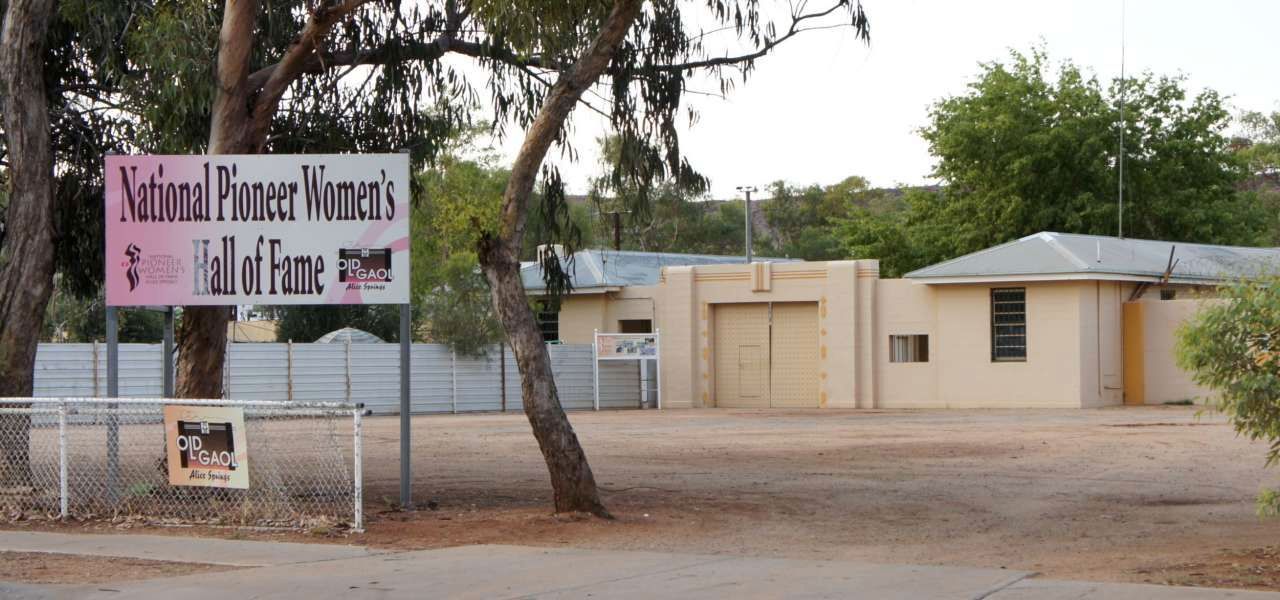
Women's Museum of Australia
The Women's Museum of Australia, located in Alice Springs, Northern Territory, is a unique and inspiring institution dedicated to celebrating the contributions and achievements of women throughout Australia's history. Originally established as the National Pioneer Women's Hall of Fame in 1993, the museum has since expanded its focus to include the diverse stories of women from all walks of life and across various fields.
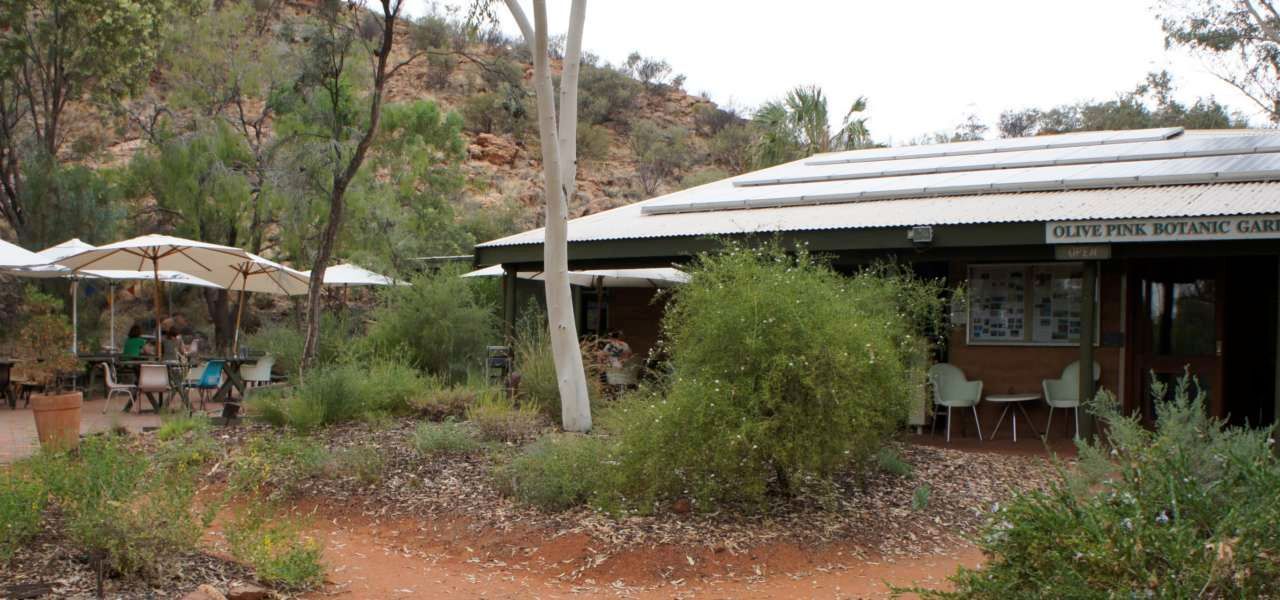
Olive Pink Botanic Garden
The Olive Pink Botanic Garden, located in Alice Springs, Northern Territory, is a unique and vibrant garden dedicated to the flora of Australia's arid regions. Named after its founder, Olive Muriel Pink, an anthropologist, artist, and advocate for Indigenous rights, the garden stands as a testament to her passion for the conservation of native plants and the cultural heritage of Central Australia.
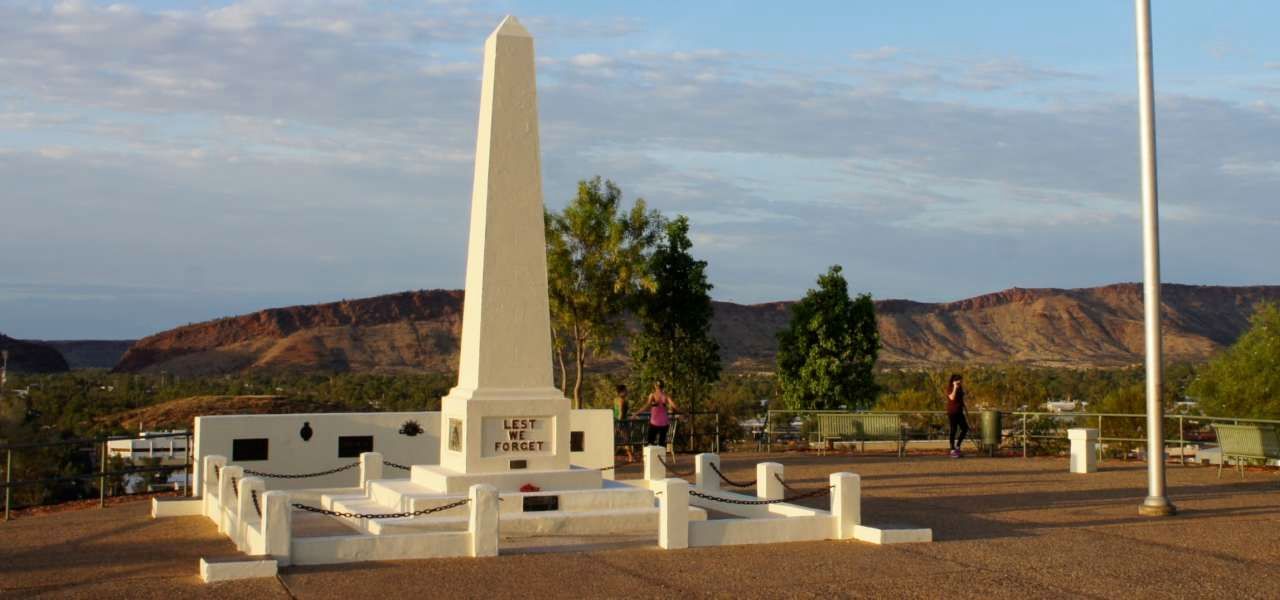
ANZAC Hill Memorial
The ANZAC Hill Memorial, located in Alice Springs, Northern Territory, is a prominent and significant landmark dedicated in 1934 honoring the service and sacrifice of Australian and New Zealand Army Corps (ANZAC) soldiers. Positioned on top of a hill overlooking the town, the memorial provides a sweeping panoramic view of Alice Springs and the surrounding landscape, making it a popular spot for both reflection and appreciation of the area's natural beauty.
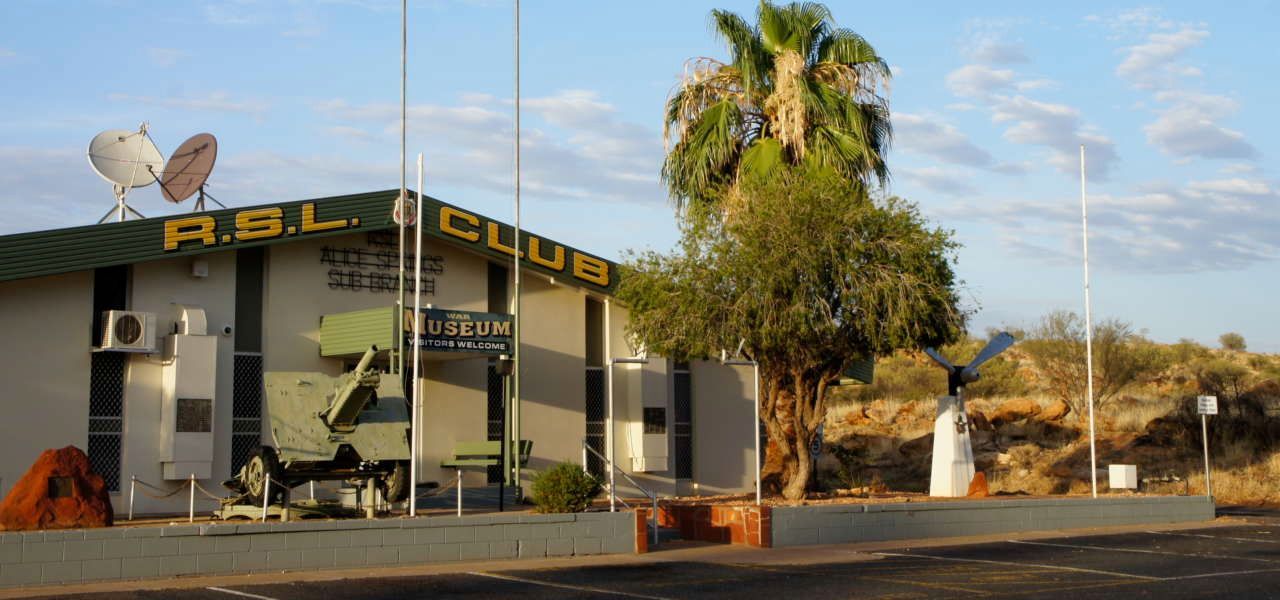
RSL War Museum
(now closed) The RSL War Museum, located in Alice Springs, Northern Territory, is a dedicated institution that honors the history and contributions of Australia's military personnel. Situated within the Alice Springs RSL (Returned and Services League) Club, the museum provides an in-depth look at the experiences of those who have served in the Australian armed forces.
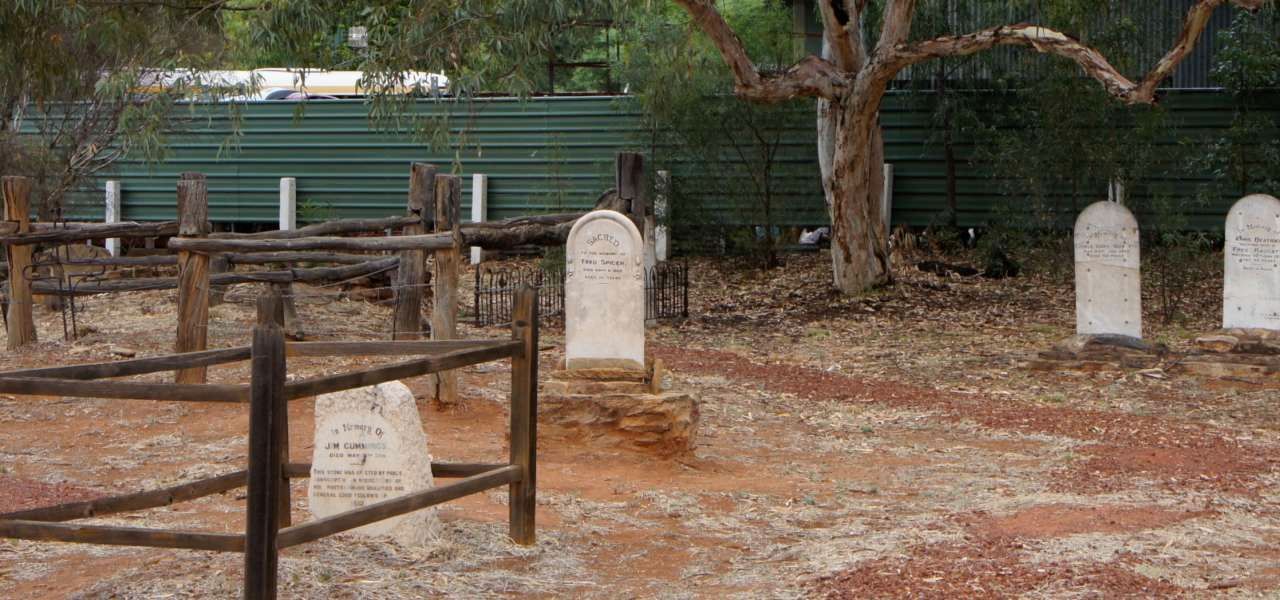
Old Stuart Town Memorial Cemetery
The Old Stuart Town Memorial Cemetery, located in Alice Springs, Northern Territory, is a significant historical site that offers a glimpse into the early days of European settlement in Central Australia. Established in the late 19th century, this cemetery is one of the oldest burial grounds in the region and serves as a poignant reminder of the challenges and hardships faced by the early settlers and pioneers.
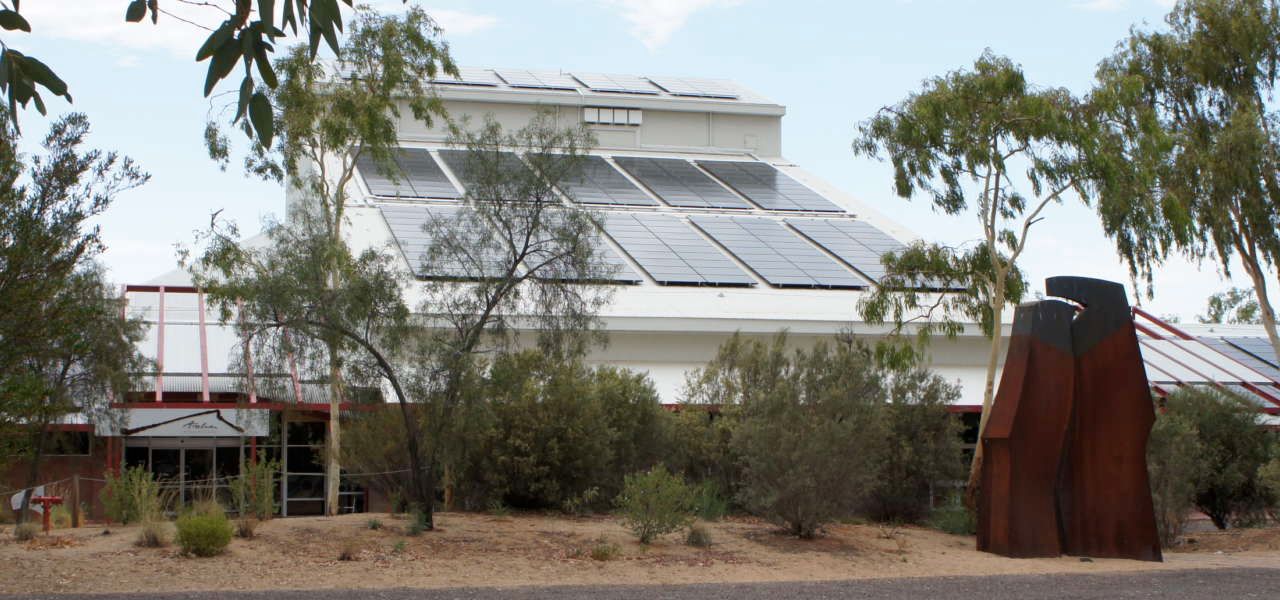
Araluen Centre Art Galleries
The Araluen Centre Art Galleries, located in Alice Springs, Northern Territory, is a premier cultural institution dedicated to showcasing the vibrant and diverse art of Central Australia. Situated within the Araluen Cultural Precinct, the galleries are part of a larger complex that includes performance spaces, heritage buildings, and outdoor exhibits, making it a hub for artistic and cultural activities in the region.
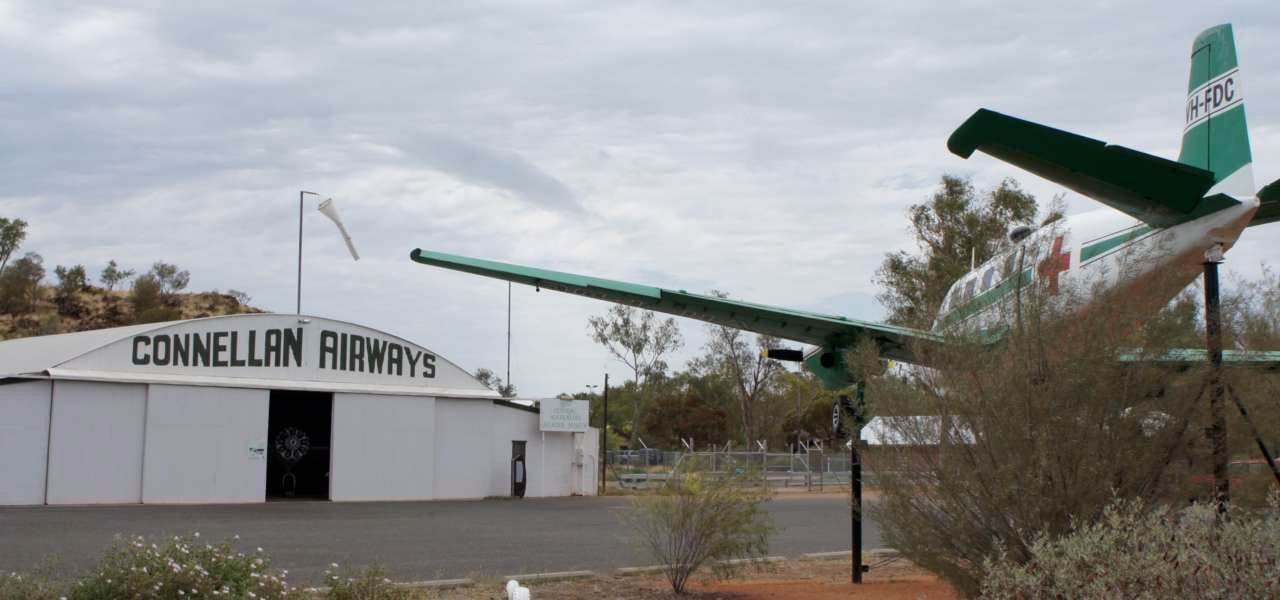
Central Australian Aviation Museum
The Central Australian Aviation Museum, located in Alice Springs, Northern Territory, is a fascinating institution dedicated to preserving and showcasing the rich aviation history of Central Australia. The museum is situated at the site of the original Alice Springs town aerodrome, which played a crucial role in the development of air travel and communication in the remote outback.
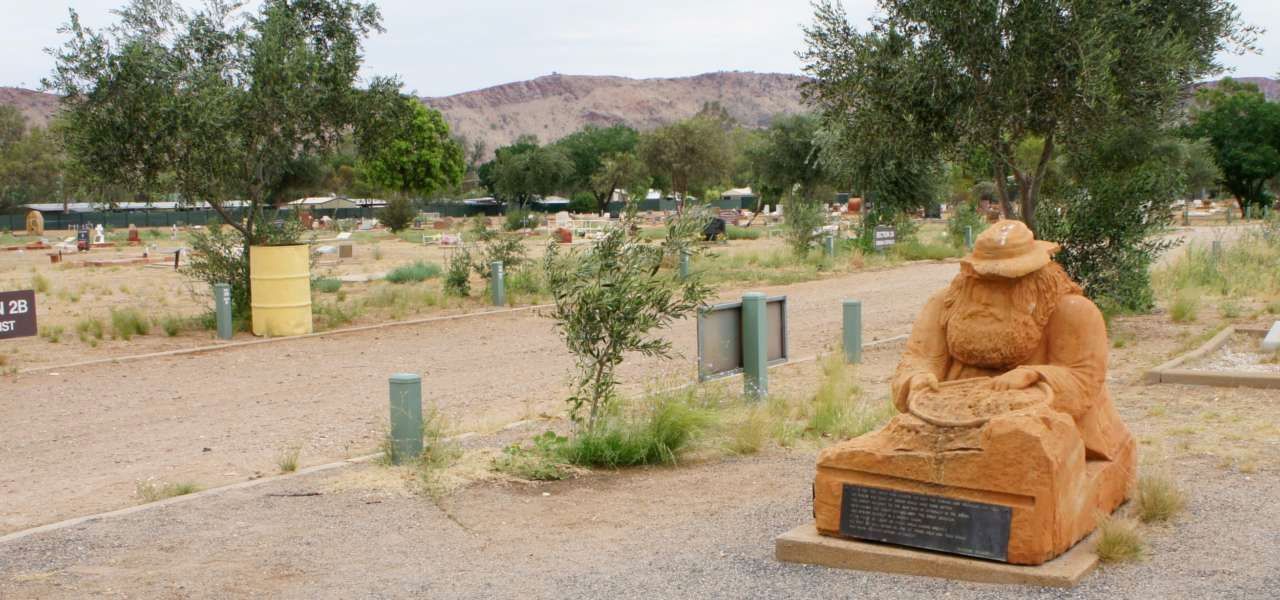
Alice Springs General Cemetery
The Alice Springs General Cemetery, located in Alice Springs, Northern Territory, is a historically significant site that offers a poignant glimpse into the town's past. Established in the early 20th century, the cemetery is the final resting place for artist Albert Namatjira, prospector Harold Lasseter and anthropologist Olive Pink.
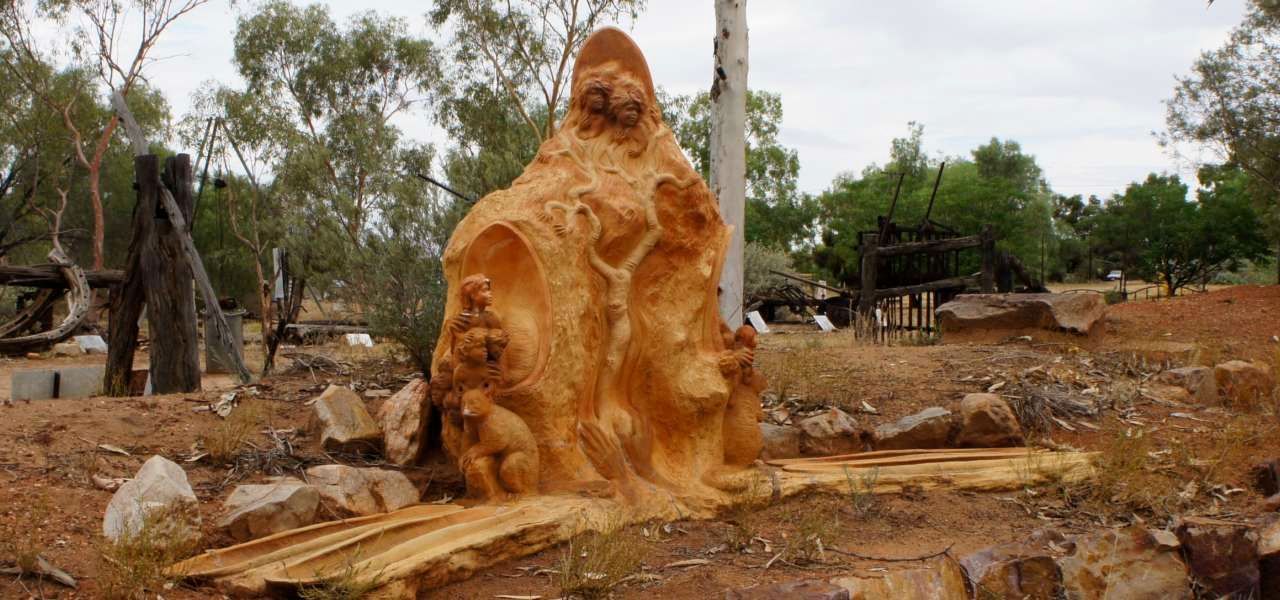
Pitchi Richi Sanctuary
Pitchi Richi Sanctuary, located just a few kilometers south of Alice Springs is a unique cultural and natural attraction that combines art, history, and nature. Established in the mid-20th century by the artist and collector Leo Corbet, the sanctuary is presently being restored by Heritage Alice Springs.
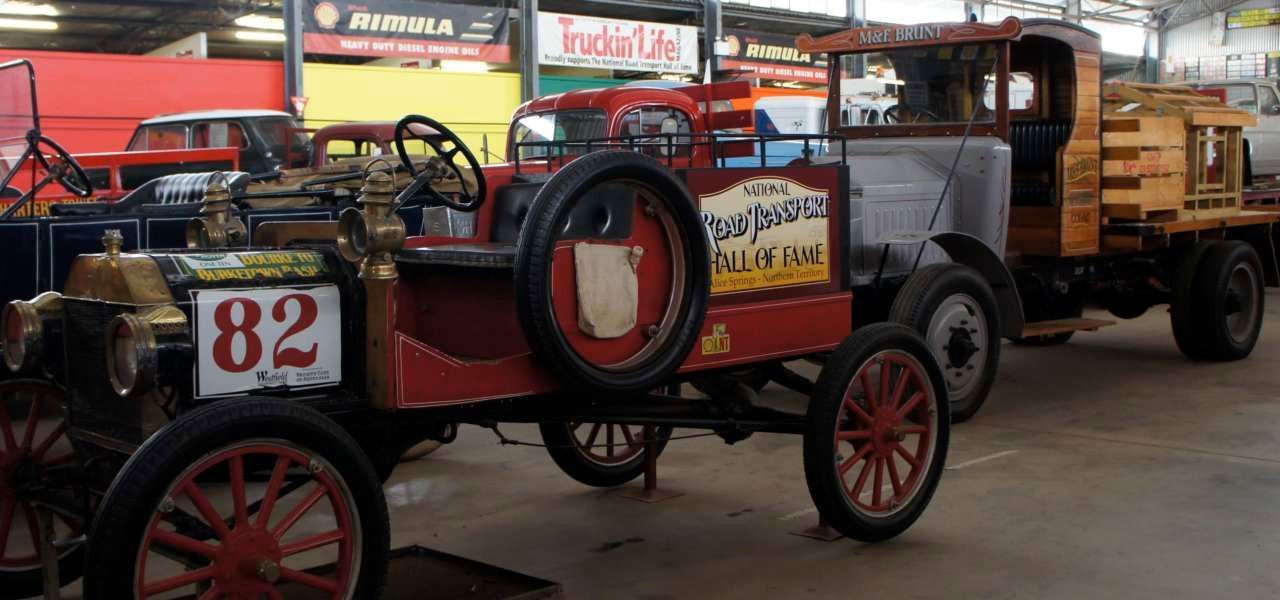
National Road Transport Hall of Fame
The National Road Transport Hall of Fame, located in Alice Springs, Northern Territory, is a premier museum dedicated to preserving and showcasing the rich history of road transport in Australia. Established in 1995, this unique museum celebrates the vital role that road transport has played in the development and connectivity of the vast Australian continent.
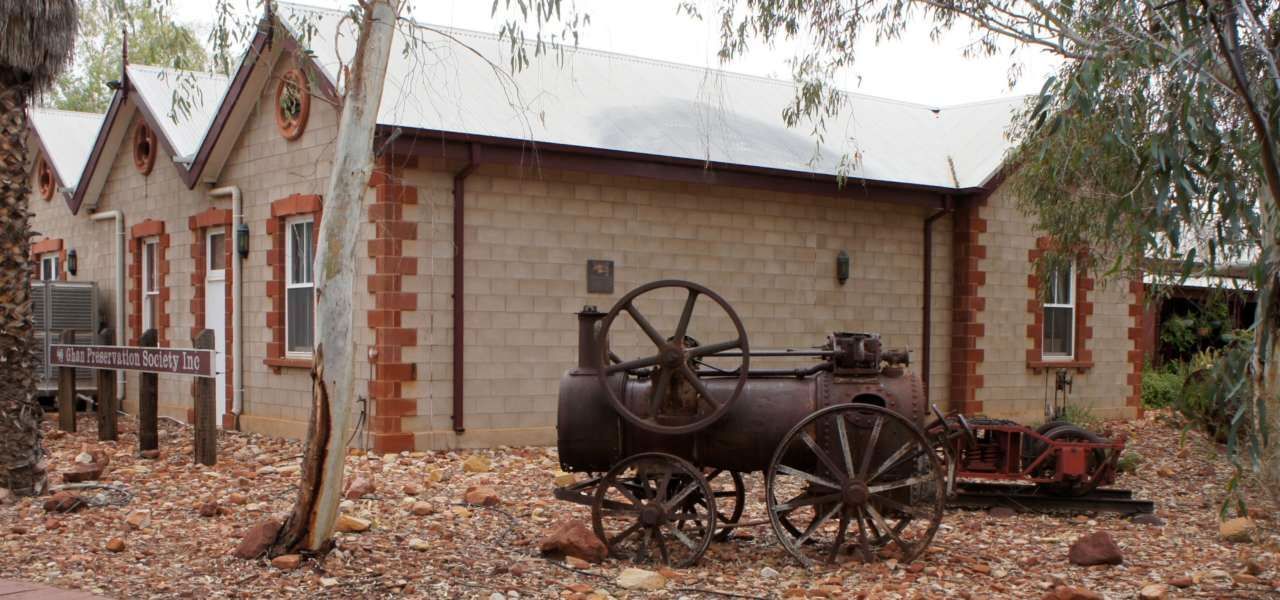
The Old Ghan Railway Museum
The Old Ghan Railway Museum, located in Alice Springs, Northern Territory, is a fascinating museum dedicated to preserving the history and legacy of the iconic Ghan Railway. Named after the Afghan cameleers who once traversed the same routes, the Ghan Railway was a critical lifeline connecting the remote interior of Australia with the southern coast, running from Adelaide to Alice Springs.

Alice Springs Telegraph Station
The Alice Springs Telegraph Station, located just north of the town of Alice Springs in the Northern Territory, is a significant historical site that marks the birthplace of the town. Established in 1872, the telegraph station was a vital link in the Overland Telegraph Line, which connected Australia with the rest of the world by enabling fast communication between Adelaide and Darwin.

Old Courthouse
The Old Courthouse in Alice Springs is a significant historical landmark located in the heart of the town. Constructed in 1928, the building served as the judicial center for the region, playing a crucial role in the administration of law and order in Central Australia.
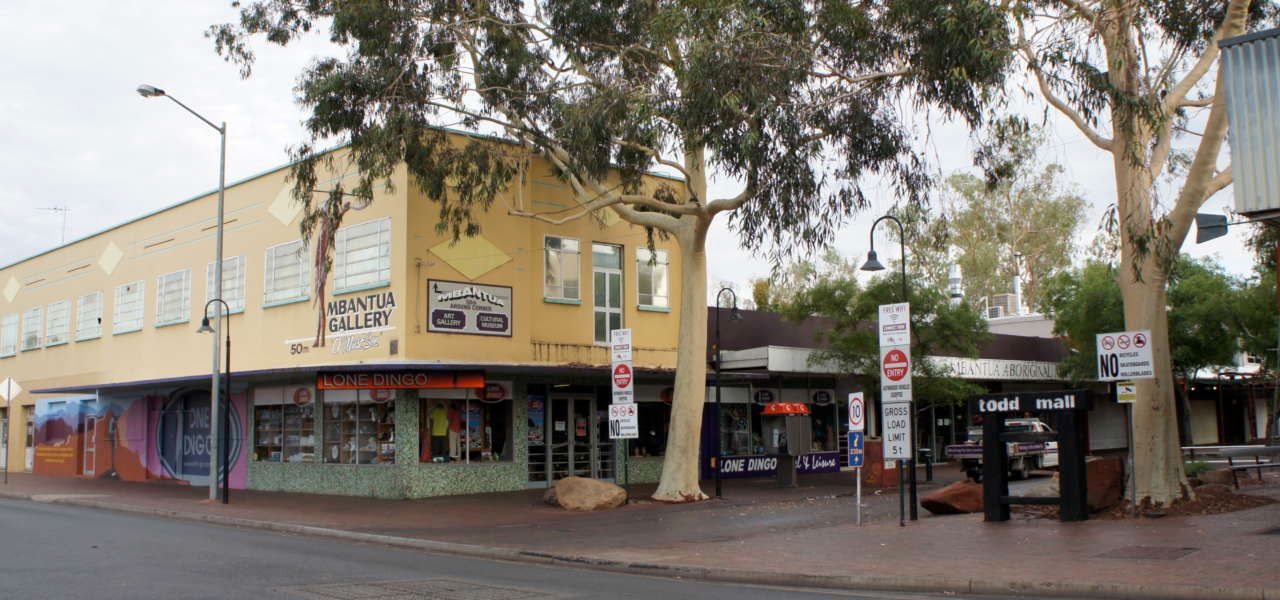
Heenan Building
The Heenan Building in Alice Springs is an iconic structure that holds historical and architectural significance. Located in the heart of the town, this building was constructed in the mid-20th century and named after the Heenan family, who were prominent figures in the local community.
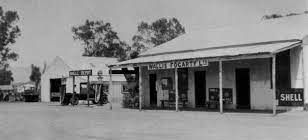
Former Wallis Fogarty Store
The Former Wallis Fogarty Store in Alice Springs is a notable historic building that reflects the commercial history of the town. Established in the early 20th century, the store was a central hub for trade and supplies in the region. Owned by Wallis Fogarty, a well-known local entrepreneur, the store provided essential goods and services to the residents and travellers passing through Alice Springs.
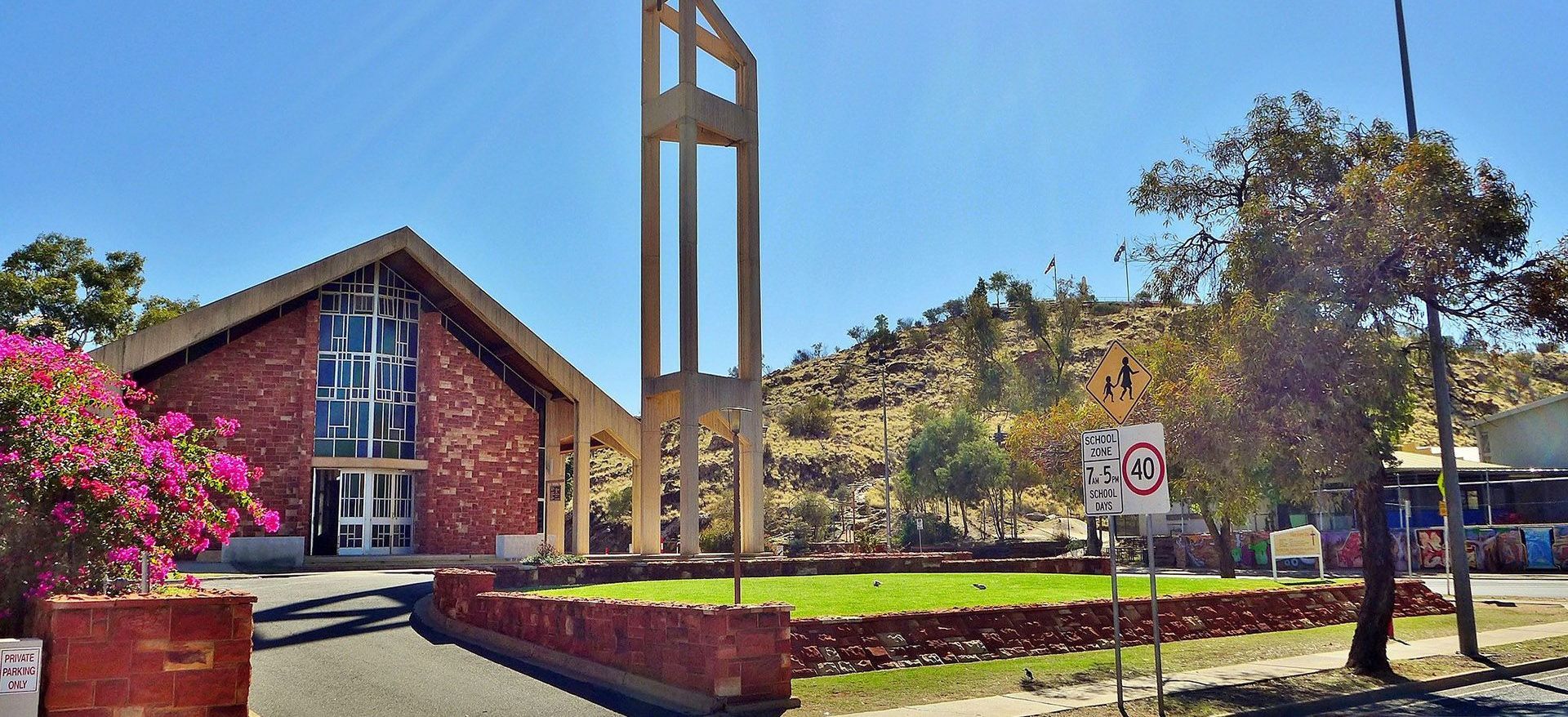
Catholic Church Precinct
The Catholic Church Precinct in Alice Springs is a significant cultural and historical site, reflecting the town's religious and architectural heritage. Located in the heart of Alice Springs, the precinct includes several important buildings, most notably the Our Lady of the Sacred Heart Church. This church, built in 1939, is an excellent example of early 20th-century ecclesiastical architecture adapted to the outback environment, featuring thick stone walls and a simple yet elegant design.

Former CWA Hall
The Former Country Women's Association (CWA) Hall in Alice Springs is a historically and culturally significant building, reflecting the important role of the CWA in the community. Established in the mid-20th century, the hall served as a central gathering place for women in the area, providing a venue for meetings, social events, and community activities. The CWA has been instrumental in advocating for the welfare of women and families, particularly in remote and rural areas.
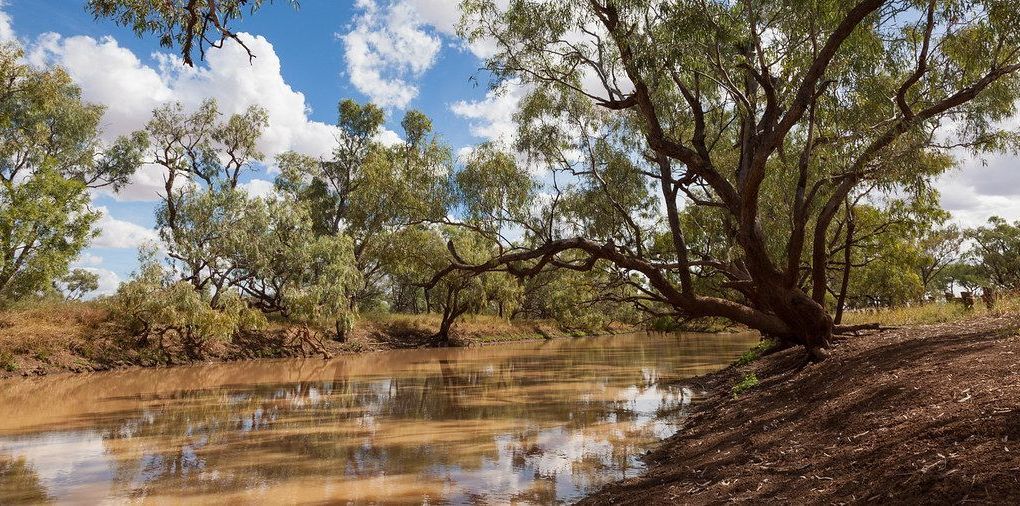
Coolibah Swamp
Coolibah Swamp is a notable natural feature located near Alice Springs in the Northern Territory. This swamp is part of a seasonal wetland system that plays a crucial role in the local ecosystem, providing a habitat for a diverse range of flora and fauna. The name "Coolibah" refers to the coolibah tree (Eucalyptus coolabah), which is commonly found in and around the swamp and is well-adapted to the variable conditions of the Australian outback.
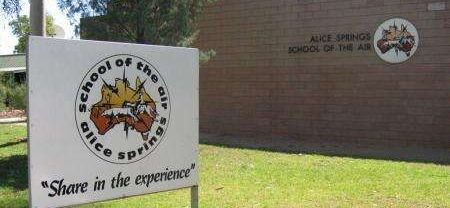
School of the Air
The Alice Springs School of the Air is an innovative and iconic educational institution based in Alice Springs, Northern Territory, Australia. Established in 1951, it was designed to provide education to children living in remote and isolated areas of the Australian outback, where traditional schooling was not feasible due to vast distances. The school uses various forms of communication technology to deliver lessons to students scattered over an area of more than 1.3 million square kilometers.
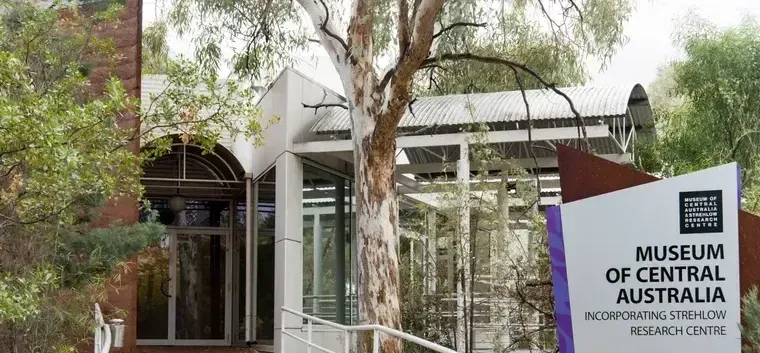
Museum of Central Australia
The Museum of Central Australia, located in Alice Springs, Northern Territory, is a premier cultural and natural history museum that offers a comprehensive look into the region's rich heritage.
The museum showcases an extensive collection of artifacts and exhibits that detail the geological, paleontological, and cultural history of Central Australia. One of the museum's highlights is its impressive display of fossils, including those from the Alcoota Fossil Beds.

Former Date Farm
The Former Date Farm, located near Alice Springs in the Northern Territory, is a historically significant site that highlights an intriguing chapter in the region's agricultural history. Established in the early 20th century, the farm was part of an experimental initiative to cultivate date palms in the arid climate of Central Australia. This initiative was driven by the belief that the region's dry conditions would be suitable for date production, similar to the date-growing regions of the Middle East and North Africa.
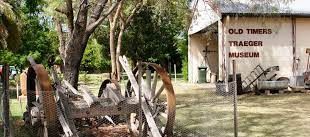
Old Timer's Museum
The Old Timer's Museum, located in Alice Springs, Northern Territory, is a charming and insightful institution dedicated to preserving and showcasing the rich history of the region's pioneering days.
Operated by the Old Timers Association, the museum offers a fascinating collection of artifacts, photographs, and memorabilia that tell the stories of early European settlers, explorers, and the development of the outback.
Around
Alice Springs
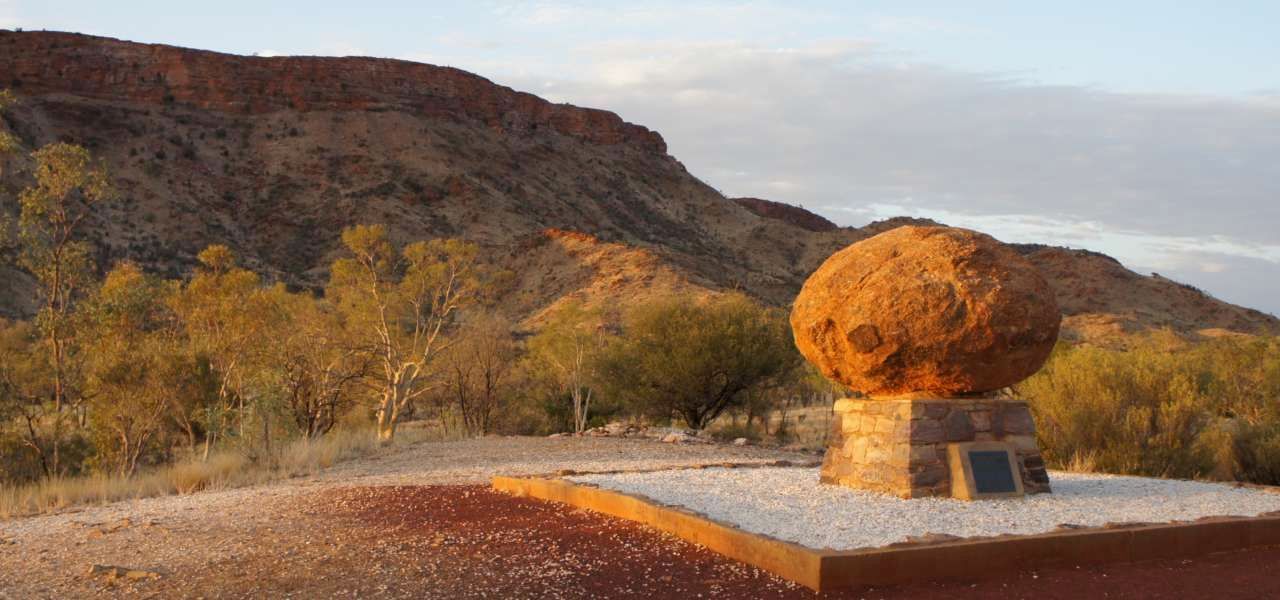
John Flynn's Grave
John Flynn's Grave is a revered historical site located at the base of Mount Gillen near Alice Springs, Northern Territory. The grave commemorates Reverend John Flynn, the founder of the Royal Flying Doctor Service (RFDS), who dedicated his life to improving medical services in remote and outback Australia.
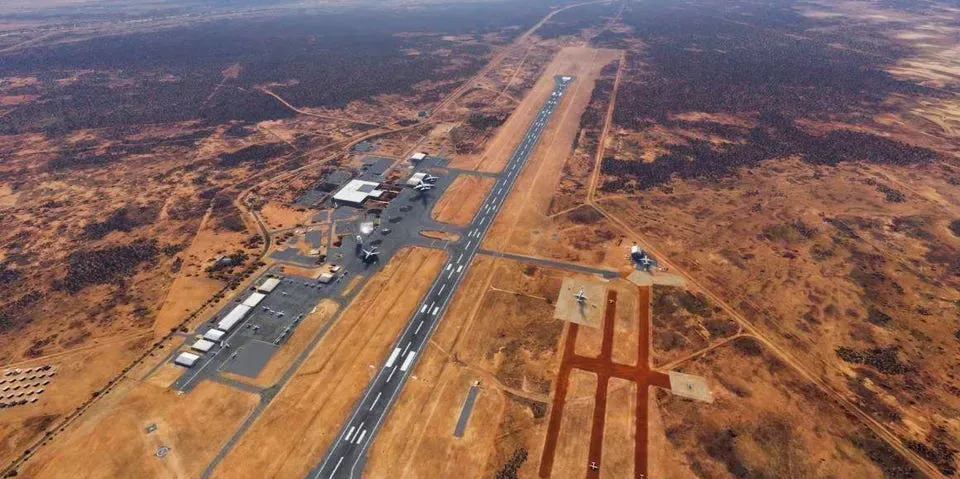
7 Mile Aerodrome
7 Mile Aerodrome, located in Alice Springs, Northern Territory, Australia, is a significant historical site. Established during World War II, the aerodrome served as a crucial military base for the Allied forces. The aerodrome features a distinctive layout, with its main runway surrounded by remnants of wartime infrastructure.
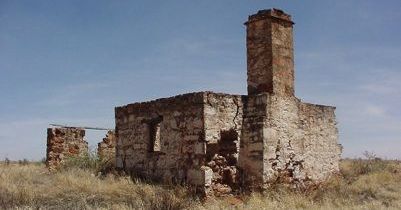
Owen Springs Homestead
Owen Springs Homestead is a historic site located near Alice Springs in the Northern Territory of Australia. Established in the 1870s, it was one of the first pastoral leases in Central Australia. The homestead played a pivotal role in the early European exploration and settlement of the region.
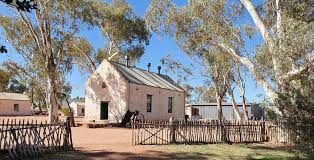
Hermannsburg Historic Precinct
The Hermannsburg Historic Precinct is a culturally and historically significant site located in Hermannsburg, Northern Territory, Australia. Founded in 1877 by Lutheran missionaries, it was originally established as a mission for the local Arrernte people.
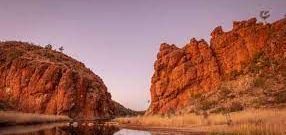
Glen Helen Homestead
Glen Helen Homestead, located in the West MacDonnell Ranges near Alice Springs, Northern Territory, is a historic and picturesque destination. Originally established as a cattle station, it has evolved into a popular tourist spot, known for its stunning natural beauty and tranquil environment.
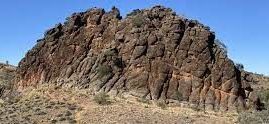
Corroboree Rock
Corroboree Rock, located in the East MacDonnell Ranges near Alice Springs, Northern Territory, is a striking geological formation and a significant cultural site for the Eastern Arrernte people. This slender, columnar rock formation stands out in the arid landscape and holds spiritual importance for the local Indigenous community.
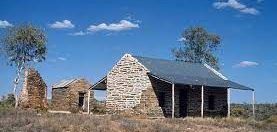
Arltunga Goldfields
Arltunga Goldfields, located about 110 kilometers east of Alice Springs in the Northern Territory, is a historic site that offers a fascinating glimpse into Australia's gold rush era. Established in the late 19th century, Arltunga was Central Australia's first significant European settlement and a bustling hub for gold mining.
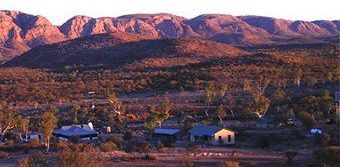
Old Hamilton Downs Homestead
Old Hamilton Downs Homestead is a historic site situated in the Northern Territory, approximately 70 kilometers northwest of Alice Springs. Established in the early 20th century, the homestead served as a pastoral station and played a crucial role in the region's agricultural development.
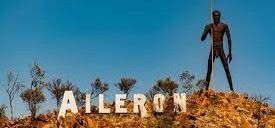
Alieron Homestead
Alcoota Station, also known as Alcoota Homestead, is a historic pastoral property located in the Northern Territory, about 150 kilometers northeast of Alice Springs. Established in the late 19th century, Alcoota has a rich history tied to cattle grazing and the exploration of Central Australia.
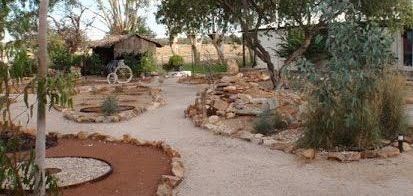
Old Ambalindum Homestead
Old Ambalindum Homestead is a historic site located in the East MacDonnell Ranges, approximately 120 kilometers northeast of Alice Springs, Northern Territory. Established in the early 1900s as a cattle station, the homestead is a testament to the pioneering spirit of the early settlers in the region.
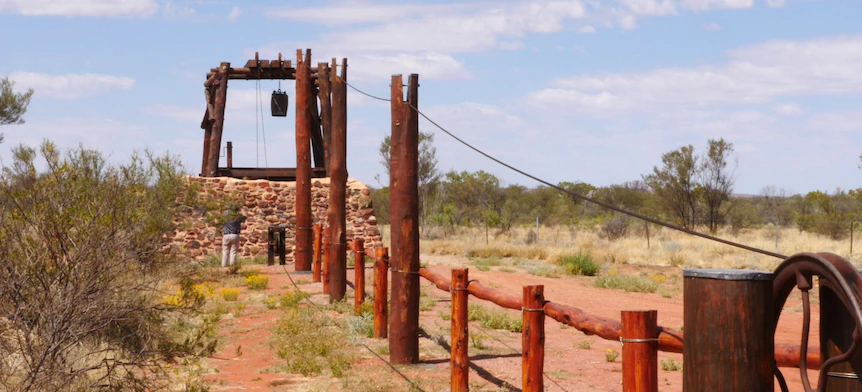
Ryan's Well
Ryan's Well is a historic site located along the Stuart Highway, approximately 129 kilometers north of Alice Springs in the Northern Territory. Constructed in 1889 by Ned Ryan, a stonemason, the well was an essential water source for travelers and livestock along the Overland Telegraph Line and the route to the goldfields at Arltunga.
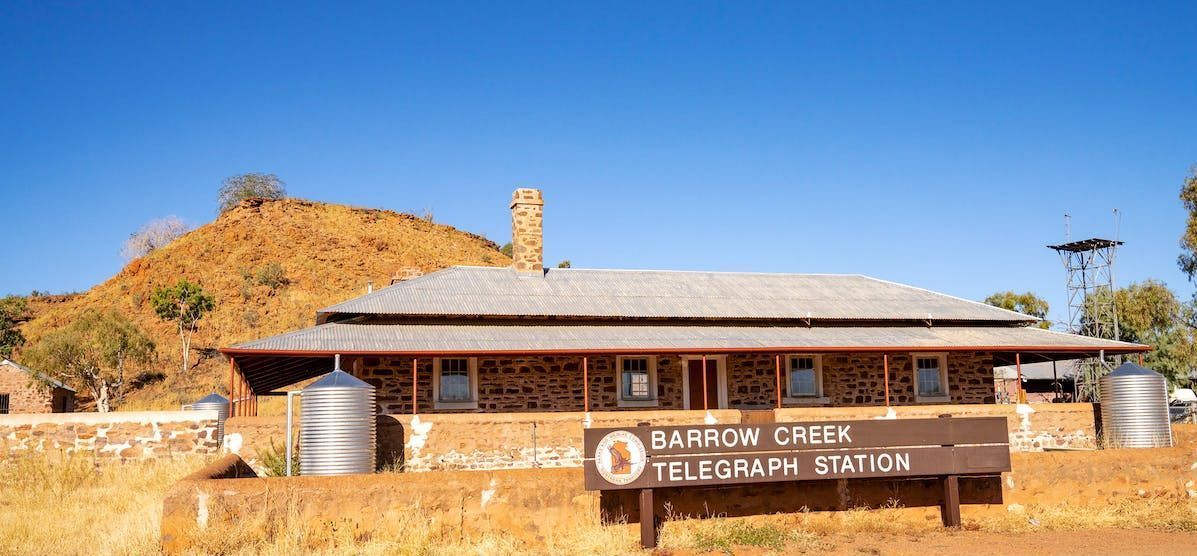
Barrow Creek Telegraph Station
Barrow Creek Telegraph Station, located approximately 300 kilometers north of Alice Springs in the Northern Territory, is one of the original telegraph stations built along the Overland Telegraph Line. Established in 1872, this historic site played a crucial role in linking Australia with the rest of the world through telegraphic communication.
Want to get involved?
Our organisation is limited only by the number of volunteers and funding available. By becoming a member, volunteering your time or making a donation, our association will be able to continue our restoration projects and run more activities.
News
& Events
Heritage Alice Springs aims to keep the community informed about news affecting heritage in the town and the Central Australian region.
Heritage Alice Springs also holds a number of events at The Residency, including the Annual Spring Flower Show and Heritage Week activities.

